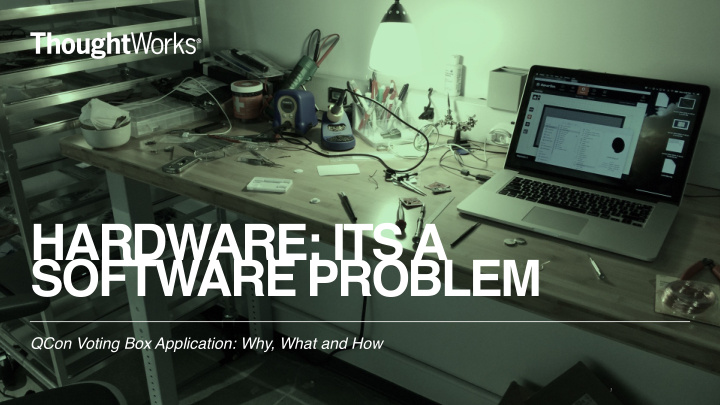



HARDWARE: ITS A SOFTWARE PROBLEM QCon Voting Box Application: Why, What and How 1
MAT HENSHALL ANTHONY MAITZ HOLLY BOWEN Head of Things - Thoughtworks 2
USER FEEDBACK IN THE PHYSICAL WORLD How to get Actionable Feedback? • Was the Session Interesting? • Useful? • How was the speaker? • Overall Value to the Attendee? Who gave the feedback? • Allows follow up • Makes conferences more relevant 3
USER FEEDBACK IN THE PHYSICAL WORLD Paper System • Very High Participation Rate • Simple • Obvious • “Frictionless” Drawback • No way to tie back to Specific Attendee 4
USER FEEDBACK IN THE PHYSICAL WORLD How to Identifying Attendees while not adding “Friction”? • Smartphone A Very well designed app was tried • Participation dropped significant Use existing NFC tags in the attendees Badge? • Could we make a system that was as ‘frictionless’ as paper? • Integrated into the QCon backend systems? • Would it be easy to operate? 5
THE CHALLENGE: 6 WEEKS TO QCON SAN FRANCISCO It isn't a simple as it seems… • Conferences use volunteer and temporary staff • Temporary Spaces Technical Infrastructure… • Patchy Wifi and connectivity • Future desire for “realtime’ leader boards and feedback 6
ARE WE BUILDING THE RIGHT THING? Human Centered Design • What seems obvious and perfect on paper…. • Is found to be awkward in the field New hardware, Industrial Design and Software • High Risk to committing to solution too early • Needed to prove: • Can the participation rates be maintained? • Capture the voter ID • Integrate with existing IT systems • Practical operational service design and deployment 7
AGILE IN A PHYSICAL WORLD Iterative approach • Validation of core ideas • Focus on fast built MVP • Are we building the “Right Thing” • “Build it right” after validation • Principles that serve us well in Software need to be modified when novel hardware and Industrial Design is included 8
CREATING AN EXPLORATORY PLATFORM How do we create an ID that can be modified in sync with high speed user- test cycles? • E.g. should there be three or four options for voting? • If a volunteer is holding a voting box, what is the best way to angle and support it? • Can we test alternative surfaces, form, details? How to evaluate the underlying tech in the surprisingly hostile technical environment? Can we achieve integration with the back end systems on site? 9
CREATING AN EXPLORATORY PLATFORM Using 3D printing • Getting better all the time • Can be ‘tweaked overnight to incorporate learnings and retest Hardware Prototyping systems • Use of core ‘SoC’ micro controllers • ‘Break out boards’ for special functions • use 3D printer to create custom fit • functional prototype maps to final production board Platform • Software quickly becomes becomes the dominant iterative tool for features 10
THE PLATFORM Battery Powered • No Wires • Last all day Blue Tooth Mesh • Solves the Wifi/Cell problem • Self Healing adhoc • Can connect to smartphone and laptop directly for capture and forward of votes • Single regulatory design for world wide deployment 11
THE DETAILS - NORDIC SEMICONDUCTOR NRF51XXX General purpose ARM based SoC • 32bit, • ultra low powered • open source tooling • Integrated BLE radio • enough RAM and Flash to run an app alongside BT stack • Cheap, widely supported Industry standard NFC chip • PN532 12
EACH ‘VOTING OPTION’ A SEPARATE NODE Simplified creation of different form factors for user testing and exploration • Each has its own batteries • Cost of making 3 or 4 times number of identical boards versus one more complex trivial Flexibility for re-use in future applications… • For example we reused today for the ThoughtWorks GoSnap exhibitors booth for collect of data… 13
LIVE USER TESTING! QCon SF - Nov 2015 • Small number of sessions • Identify any overall issues with service design • Details of ID and technical infrastructure issues Lessons learnt… • NFC tags were randomly placed in badges… • Increased friction as the ‘golden spot’ was sought • Feedback of a successful vote • More LEDS needed! • Need a buzzer! • Badge stuffing • NFC tag obscured by business cards 14
WILL IT SCALE? QCon London March 2016 • Candidate production board • Trip to Shenzhen to work with ODM (Seeed Studios) Real hardware that incorporated all the feedback from prior tests • “Build it right” stage Production run of 50 nodes • Tested in the field • Minor issues around design • Able to validate most of the design and ideas in London 15
“BUILDING IT RIGHT” - VALIDATION OF SOFTWARE 16
PRODUCTIONIZATION Integrate novel testing solutions into the CI process • Software builds can be automatically loaded into a test bed of devices • Test scripts using ‘robots’ can be fired to validate the new firmware • Hardware and ID Platform stable • Software continues to evolve New ‘Board Spin’ in Shenzhen • Typically plan for three or four spins • Initial candidate • Fix issues plus minor enhancements • Final production candidate • Radio and certification fixes - as required 17
HARDWARE REALLY IS A SOFTWARE PROBLEM Using standard hardware modules to create functional prototypes, the hard hardware bits can be isolated and left to specialists Majority of a solutions features are expressed in software running on the modules Creating a lego like environment where we can mix and match Except there is nasty reality of custom hardware where choosing the right ODM helps alleviate that… but requires constant management. 18
THANK YOU For questions or suggestions: mhenshal@thoughtworks.com tmaitz@thoughtworks.com
Sometimes you need a blank template. 20
Recommend
More recommend